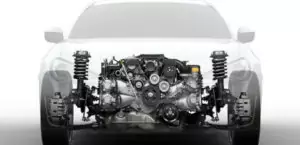The Suzuki G13B 1.3-litre petrol engine was produced in Japan from 1986 to 1995 and was used in powered versions of the Swift GTi and the similar Cultus GTi in the first two generations. Many confuse this DOHC unit with its SOHC counterpart G13BB, which was installed on the Jimny.
Engines of the G-series: G10A, G13B, G13BA, G13BB, G15A, G16A, G16B.
Specifications
| Production years | 1986-1995 |
| Displacement, cc | 1298 |
| Fuel system | distributed injection |
| Power output, hp | 100 – 115 |
| Torque output, Nm | 109 – 112 |
| Cylinder block | aluminum R4 |
| Block head | aluminum 16v |
| Cylinder bore, mm | 74 |
| Piston stroke, mm | 75.5 |
| Compression ratio | 10 – 11.5 |
| Features | DOHC |
| Hydraulic lifters | no |
| Timing drive | belt |
| Phase regulator | no |
| Turbocharging | no |
| Recommended engine oil | 5W-30 |
| Engine oil capacity, liter | 3.2 |
| Fuel type | petrol |
| Euro standards | EURO 2 |
| Fuel consumption, L/100 km (for Suzuki Swift GTi 1987) — city — highway — combined |
7.8 5.5 6.3 |
| Engine lifespan, km | ~280 000 |
| Weight, kg | 82 (without attachments) |
The engine was installed on:
- Suzuki Cultus 1 (SA) in 1986 – 1988; Cultus 2 (SF) in 1988 – 1994;
- Suzuki Swift 1 (AA) in 1986 – 1989; Swift 2 (EA) in 1989 – 1995.
Disadvantages of the Suzuki G13B engine
- The main thing is not to allow the motor to overheat, then it will serve for a long time and without problems;
- Overheating cracks the cooling jacket of the aluminum block, and sometimes the cylinder head;
- Also, the exhaust manifold often bursts, but it is quite possible to brew it;
- Quite a few problems here are due to the vagaries of an outdated ignition system;
- It does not have hydraulic lifters and the valve clearance needs to be adjusted every 30,000 km.







the g13b dohc (pictured) does have hydraulic lifters. It also did come with a turbo in japan.
Yes to hydraulic lifters but there was never a factory turbo of this engine. Any turbo G13B was done up by the owner. In Japan, the Cultus GTi with the G13B had more power, mostly by way of higher compression and was available with AWD though. There was a 70hp turbo of the 1.0 3 cylinder (G10) in the early years, which was also available in Canada as the Chevrolet Sprint and Pontiac Firefly Turbos.